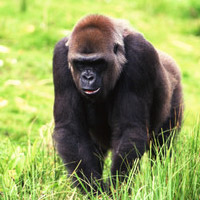Mammals - Lowland Gorilla
 Region:
Africa Region:
Africa
Class: Mammalia
Order: Primata
Family: Hominidae
Genus: Gorilla
Scientific Name: Gorilla gorilla gorilla
Description: Gorillas are the largest of the primates,
the Mountain Gorilla (Gorilla beringie) being only slightly
larger than the Lowland Gorilla and with thicker and longer
hair. Weight ranges from 85 to 175 kg with males being
twice as heavy as females. Weights of 290 kg. for a male
and 100 kg. for a female are on record. Captive gorillas
tend to weigh more. The male is very stocky and powerful
in the body, with wide shoulders and chest. The females
are much smaller and lighter.
Distribution: Congo River basin of Western Africa.
Habitat: Lowland rain forest.
Food: Mainly juicy plant stems, vines and leaves. Bark,
roots and fruits are also taken, the choice parts being
selected, the remainder discarded. There is a definite
preference shown in plant selection, wild celery, thistles,
nettles, bamboo shoots and bedstraw (Galluim) are among
those chosen.
Skin/Color/Coat: The colour of the coat varies considerably,
ranging through black, silver and shades of red. Black
is more usual. The skin is also black. As a male gorilla
reaches physical maturity (between 12 and 15 years of
age), he develops his silvery grey colouration. Old males
often lack chest hair. The face, ears, palms and soles
of feet are bare.
Vocalization: The gorillas vocalize a great deal from
the throat. Roars, growls, barks, grunts, purrs, croaks,
hoots, squeaks and screeches are among those used. They
can very effectively warn each other of impending danger
and intimidate intruders. The hooting sound is usually
the prelude to the climax to their emotional expression
- the drumming display. Flat or slightly cupped hands
are beat in rapid alternation upon the chest, abdomen,
hips, tree trunks, on the ground, or on anything that
is handy. Drumming sounds the alarm in case of danger,
threatens the invader, but it may also be done in play.
Reproduction and Development: Females mature sexually
at 6-8 years, with the onset of menstruation and are fully
grown at 8-10 years of age. The males are sexually mature
at 8-10 years and fully grown at 12-15 years. In male
apes as in man, potency, once achieved, is continuous
until it is lost through disease or senescence. Female
gorillas have a menstrual cycle similar to that in humans,
the average length being 30-31 days. In the wild, copulation
is normally dorso-ventral, in captivity both dorso-ventral
and ventro-ventral copulations occur. The average gestation
period is 265 days. A single young is born weighing approximately
2 kg. The baby gorilla is completely dependent on its
mother for food and protection. At birth they appear to
lack the strength to grasp their mother's hair, so she
will support her infant with both hands. When on the move,
she cradles the infant to her breast with one hand. The
infant stays with the mother for the first three years
of its life. It begins to eat vegetable matter at about
6 weeks of age, but nursing continues for another year
and a half to two years. By one month, the infant clings
to its mother unaided; by three months it rides on its
mother's back; by four or five months it can walk unaided,
by six months it can climb as well and it is most active.
Young gorillas are very playful. Juveniles climb more
frequently and with greater ease than the adults. Very
often other females will play the role of "aunt"
to a baby and participate in its care, playing with it
and carrying it around. Gorillas live in fairly stable
groups of 5 to 15 individuals. Larger bands consist of
an adult male, several younger males and a large number
of females with their young. Smaller groups may consist
of only one adult male with a few females and their young.
The oldest gorilla in captivity was "Massa"
who died at the age of 54 in the Philadelphia Zoo.
Adaptations: Gorillas are strictly diurnal in habit, building
nests to rest in each night. Day nests are built as well.
Both types of nests may be built on the ground or in trees.
When they build in trees, they are seldom more than 9
metres from the ground. The adult male because of his
size does not build nests in trees. Nests are occupied
for one night only. Gorillas collect their varied foods
mainly on the ground. Gorillas are quiet most of the time,
they enjoy dozing and sunbathing in the mid-morning between
bouts of feeding. Postures, gestures, facial expressions
and vocalizations are all used in communication within
the group. Only one or two sounds carry far enough to
reach other groups; one of them is the chest beating sound
and also the sound heard during the intimidating display
that gorillas frequently give among themselves or to an
intruder. This display includes rising on its legs, throwing
vegetation in their, leg kicking, running sideways, slapping
and tearing nearby vegetation, and thumping the ground.
Many variations occur, and some acts may occur alone.
Aggressive charges rarely result in serious physical combat,
the gorilla avoids conflict until extremely hard pressed;
the dominant male always acting in defense of his group.
Threats: The gorilla's chief enemy is man. Gorillas are
widely hunted for "bush meat" and the young
are collected for sale, a practice that is now illegal.
The leopard is also a threat.
Status: Endangered. The population has been severely reduced
due to wars, logging and the
References: (1)Baillie, J. & B. Goombridge, 1996 IUCN
Red List of Threatened Animals, IUCN, Gland, Switzerland,
1997, Pp. 368. (2)Nowak, Ronald, M., Walker’s Mammals
of the World, Fifth Edition, Vol. 1, 1991, Pp. 503-06. |
|
|
